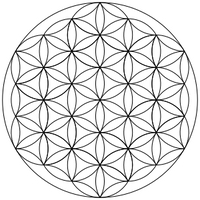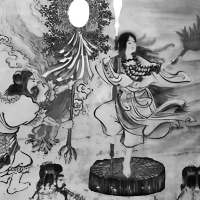木漏れ日
Komorebi
About
Mission ↓
Concept
Komorebi (木漏れ日) is a Japanese word for the sunlight that filters through tree leaves. The word is often used in haiku poetry.
The Komorebi art project unfolds a poignant narrative of inner turmoil and solitude — a universal tale resonating across time and borders.
Through interactive scenography, a minimalistic stage showcases the main character’s memories and dreams, projecting symbolic layers in a dynamic interplay with the dancer and their expression of the emotional journey.
The creation combines experimental sound design, projection mapping, poetry and movement.
The character of our original story reconciles with his painful past, on a personal and spiritual level.
His story of redemption will bring hope for new generations, in the form of a bright ray of light.

Genesis
“I wanted to express struggle, suffering and loneliness through new art form with a light of hope.”
– Masami Mikami
In 2020, Masami Mikami conducted an interview with a Montreal individual whose life story became the foundation of the project.
His story is symbolized by the shape of the geodesic dome, which was a symbol of Montreal’s Expo 67, the era in which he was born.
Our production illuminates a journey from despair to redemption, where a single beam of light charts a course of hope, beauty, and enlightenment.

Inspirations
The following are key sources of inspiration for this project.
Shinto
Every culture has its own mythology and legends. They transmit the spirituality of ancient ancestors to their ascendants; accordingly mythology and legends are valued as the most important cultural heritage of the people.
In Japan, the Kojiki (The Record of Ancient Matters) is the oldest form of literature that presently exists. It was compiled in 712 A.D. by order of the Emperor. According to the Kojiki, in the beginning of the universe there appeared various deities (kami) from the chaos. A male kami and a female kami appeared at the end and gave birth to the islands of Japan as well as the natural environment and several more deities who became ancestors of the Japanese.
The ancient Japanese considered that all things of this world have their own spirituality, as they were born from the divine couple. Therefore, the relationship between people and the natural environment was seen as a bond of blood-kin, similar to that between siblings.


Japanese Buddhism
Zen
Zen values simplicity and directness in understanding reality and responding to it in the present moment. It teaches that whatever appears before one’s eyes or beneath one’s feet is an expression of ‘suchness.’
Concept of time
In Buddhism, time refers to an interval on an individual’s mental continuum between the experience of two sequential events. Since mental continuums have no beginning and no end—and thus time also has no beginning and no end—the two events may not both occur in one lifetime. A period of time, then, is not something that exists independently of the two sequentially related events or a person’s experience of them.

Butoh
Butoh in its original form deeply informs this project through its exploration of transformation, impermanence, and embodied connection to nature. Rooted in Japanese aesthetics, Butoh embraces slowness, stillness, and the interplay of light and shadow. It shares common ground with Zen Buddhism and Shintoism, emphasizing the body’s dissolution into its surroundings.
Through its raw, unrefined movements, Butoh mirrors nature’s cycles of decay and renewal, reinforcing themes of introspection, resilience, and the fluid boundaries between the self and the natural elements.
Canadian Contemporary Art and Culture
Canadian contemporary art and culture from the 1960’s and 1970’s.
The Komorebi original story took place in this cultural backdrop.
We integrate iconic and symbolic elements of Expo 67 and more specifically the geodesic dome designed by Buckminster Fuller for the U.S. pavillion, which remains a key feature of Montréal’s landscape today. Fuller had executed the construction with architect Shoji Sadao, a long time partner.
Buckminster Fuller was a visionary architect, inventor, and futurist who imagined a harmonious and /sustainable world. His innovative designs, like the geodesic dome exemplified by the U.S. Pavilion at Expo 67, symbolize efficiency, beauty, and interconnectedness, envisioning a future where art and science converge to nurture a thriving planet.
Another source of inspiration from this period comes from the Flower Children, whose ideals of peace, love, freedom and interconnectedness resonated with Fuller’s vision.

Flower of Life
Practitioners of sacred geometry believe that repeating patterns demonstrate the interconnection of life on Earth and universal existence.
Flower of Life design can also symbolize the interconnectedness of life on Earth from a scientific and ecological standpoint.
Leonardo da Vinci
Leonardo da Vinci explored the unity of art, science, and geometry, most famously in “Vitruvian Man“. In this drawing, the human body is perfectly inscribed within a square and a circle, reflecting the Renaissance idea that the human being is a microcosm of the universe. The square symbolizes the material world, while the circle represents the infinite and the cosmic.
Here we see his drawing superimposed on the Flower Of Life.


References
Shinto
Kojiki (Wikipedia)
Jinja Honcho (Association of Shinto Shrines): Spiritual Beliefs – Nature Worship
Ise Shrine (Ise-jingū): Rituals and Ceremonies
Video: Ise Shrine (Ise-jingū): General Presentation.
Video: Ise Shrine (Ise-jingū): Ceremonies
Japanese Buddhism
Stanford Encyclopedia of Philosophy: Japanese Zen Buddhist Philosophy
Buddhist and Scientific Understandings of Time: The Nature of Time
Canadian Contemporary Art and Culture
Jean-Drapeau Park, Montréal: The Biosphere through time
Flower Child (Wikipedia)
About Fuller – The Buckminster Fuller Institute
Buckminster Fuller (Wikipedia)
The Flower of Life
Flower of Life Meaning and Symbolism
Leonardo da Vinci
Mission
To explore how interdisciplinary arts can reflect universal issues via sensory storytelling by further developing the narrative with new technology.
Objectives
- To combine different artistic disciplines to create a well-blended new art presentation, using media art as a connective force.
- To work with the inherent complexities and the complementarities of different artistic disciplines to achieve a simple and universally accessible narrative.
- To use this work to open a dialogue with the audience, particularly with younger generations, and to allow them to express themselves freely on related topics such as loneliness and social disparities.
Concept ↑


